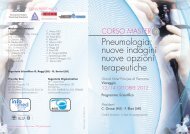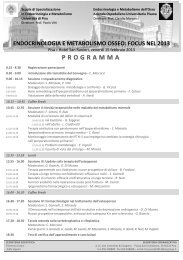Create successful ePaper yourself
Turn your PDF publications into a flip-book with our unique Google optimized e-Paper software.
Laura Candiotto<br />
26b1-3 Socrates applies this concept to seasons.<br />
The harmony of opposites is connected by Eryximachus, however briefly, to divination and religious<br />
practice. Again in the Timaeus 42 we find a reference consistent with this topic, concerning the mixture<br />
of opposites within the liver that enables the operation of divination during sleep 43 . This passage<br />
enables us to grasp how the law of harmony acts not only between congener elements but, like in this<br />
case, also between images and physical elements – sweet and bitter – that constitute the liver.<br />
These passages – it would be possible to mention and analyze many others – are in my opinion the<br />
sign of a general 44 thematic concordance between Plato and Hippocrates in relation to a “cosmological<br />
medicine” and, more specifically, the sign of a conformity between Eryximachus discourse and<br />
platonic philosophy 45 . In the meanwhile, however, Plato’s effort in detecting and incrementing the<br />
philosophical meaning of Hippocratic medicine testifies his will to guarantee the epistemic primacy of<br />
philosophy and therefore to create a certain dependency of medicine on philosophy 46 . The predilection<br />
for the theory of the similar over the theory of contraries is a clue to Plato’s predilection for<br />
Empedocles rather than Heraclitus and for the theory of contraries presented by the Corpus<br />
Hippocraticum 47 .<br />
Harmonic education and cosmological medicine<br />
Corporeal illness, unhappiness, folly and the ignorance of the soul 48 , disorder at a meteorological<br />
level, religious impiety, hybris from an ethical and political perspective are expression of an infraction<br />
of the harmonic law which regulates the universe.<br />
These aspects emphasize the necessity of a technique which is able to re-create harmony<br />
taking celestial harmony as a model. The musical image of harmony is considered in this article<br />
mainly from the perspective of cosmological medicine, in other words, as a medical-demiurgical<br />
technique inserted in a cosmological contest 49 . The ethical and educative role of harmony (the<br />
references to the Laws 50 and the Republic 51 are central in relation to this theme) becomes thus<br />
meaningful in a holistic vision, where the praxis oriented towards the construction of the right<br />
harmony of the physical universe – but also of institutions and laws – takes celestial harmony as a<br />
model.<br />
In Plato, cosmological medicine – typical of an important part of the Hippocratic Corpus –<br />
takes up a philosophical meaning which pervades all fields of human activity, including ethics and<br />
politics. Arguably, Eryximachus’ discourse is thus expression of the platonic tendency to translate on<br />
the philosophical plane the implications of a model peri physeos.<br />
However, the harmonic technique cannot order everything once and for all. In the same way<br />
in which the demiurge’s act is a continuous series of exhortations to the chora 52 , so in the narrative<br />
framework the doctor Eryximachus advises against excessive drinking (in other words, he gives the<br />
prescription and provides the motivations), but he needs to obtain the consent of the patient, who will<br />
subsequently decide freely. The text in fact emphasizes that everyone will drink as he pleases 53<br />
without getting drunk. Eryximachus presents himself thus as a free doctor, using the terminology of<br />
the well-known passage of the Laws 54 in relation to the difference between doctors who are free and<br />
doctors who are slaves.<br />
Harmonic praxis is thus always linked to the theme of moral responsibility: the philosopher is<br />
also doctor, musician and demiurges in his harmonizing activity. Accordingly, there is no primacy of<br />
the physical plane over the ethical one, or of the ethical over the physical, but – we could say inspired<br />
by our theme – a reciprocal and harmonic relation.<br />
42<br />
Tim. 71 c3-d4.<br />
43<br />
Barker 2000.<br />
44<br />
This perspective is in contrast with that of Levin (2009), who maintains that in the <strong>Symposium</strong> Plato firmly criticizes the<br />
medical technique and seeks to limit the philosophical pretenses of medicine.<br />
45<br />
Accordingly, he does not represent the model of doctor which Plato seeks to oppose. Leven (2009) and others does not<br />
agree with this perspective.<br />
46<br />
According to Cambiano this was precisely what Hippocrates sought to avoid. Cf. Cambiano 1991, p. 41.<br />
47<br />
Cf. Thivel 2004, p. 42.<br />
48<br />
Cf. Tim. 86b1-4.<br />
49<br />
Brès 1973, pp. 287-319.<br />
50<br />
Leg. VII 790.<br />
51<br />
Third book.<br />
52<br />
For an ethical and political significance cf. Casertano 2003.<br />
53<br />
Symp. 176 e1-3.<br />
54<br />
Leg. IV 720 c-e.<br />
198




